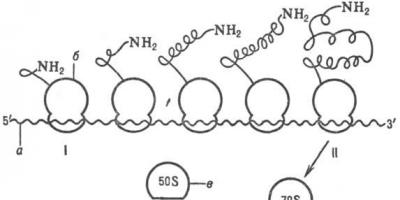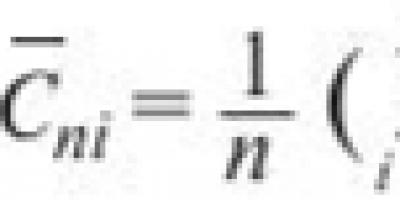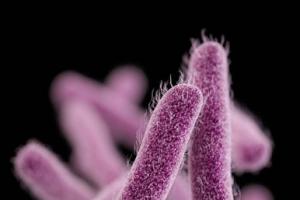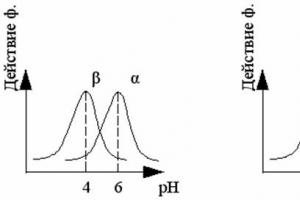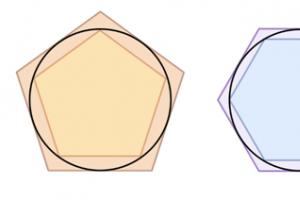Starch (C 6 H 10 O 5) n is the most important representative of polysaccharides in plants. This storage polysaccharide is used by plants as energy material. Starch is not synthesized in the animal body; glycogen is a similar reserve carbohydrate in animals.
Starch is not a chemically individual substance. In addition to polysaccharides, its composition includes minerals, mainly represented by phosphoric acid, lipids and high-molecular fatty acids - palmitic, stearic and some other compounds adsorbed by the carbohydrate polysaccharide structure of starch.
In the endosperm cells, starch is found in the form of starch grains, the shape and size of which are characteristic of this type of plant. The shape of starch grains makes it possible to easily recognize the starches of different plants under a microscope, which is used to detect the admixture of one starch in another, for example, when adding corn, oat or potato flour to wheat flour.
In the storage tissues of various organs - tubers, bulbs, larger starch grains are stored in amyloplasts as secondary (reserve) starch. Starch grains have a layered structure.
The structure of carbohydrate components of starch
The carbohydrate part of starch consists of two polysaccharides:
1. Amylose;
2. Amylopectin.
1 The structure of amylose.
In the amylose molecule, glucose residues are linked by glycosidic a1 ® 4 bonds, forming a linear chain (Fig. 8, A).
Amylose has a reducing end ( A) and non-restorative ( IN). Linear amylose chains containing from 100 to several thousand glucose residues are capable of spiraling and thus taking on a more compact shape (Fig. 8, b). Amylose dissolves well in water, forming true solutions that are unstable and capable of retrogradation- spontaneous precipitation.
Rice. 8. Starch, its structure. Amylose and amylopectin:
A- diagram of the connection of glucose molecules in amylose; b- spatial structure of amylose; V- diagram of the connection of glucose molecules in amylopectin; G- spatial molecule of amylopectin
2 The structure of amylopectin
Amylopectin is a branched component of starch. It contains up to 50,000 glucose residues, connected mainly by a1 ® 4 glycosidic bonds (linear sections of the amylopectin molecule). At each branch point of a glucose molecule (a- D-glucopyranoses) form an a1 ® 6 glycosidic bond, which makes up about 5% of the total number of glycosidic bonds in the amylopectin molecule (Fig. 8, c, d).
Each amylopectin molecule has one reducing end ( A) and a large number of non-reducing ends ( IN). The structure of amylopectin is three-dimensional, its branches are located in all directions and give the molecule a spherical shape. Amylopectin does not dissolve in water, forming a suspension, but when heated or under pressure it forms a viscous solution - a paste. With iodine, a suspension of amylopectin gives a red-brown color, while iodine is adsorbed on the amylopectin molecule, so the color of the suspension is due to the color of the iodine itself.
As a rule, the amylose content in starch ranges from 10 to 30%, and amylopectin - from 70 to 90%. Some varieties of barley, corn and rice are called waxy. In the grains of these crops, the starch consists only of amylopectin. In apples, starch is represented only by amylose.
^ Enzymatic hydrolysis of starch
The hydrolysis of starch is catalyzed by enzymes - amylases. Amylases belong to the class of hydrolases, a subclass of carbohydrases. There are α- and b-amylases. These are single-component enzymes consisting of protein molecules. The role of the active center in them is performed by the groups – NH 2 and – SH.
^ Characteristics of α-amylase
α – Amylase is found in the saliva and pancreas of animals, in molds, in sprouted grains of wheat, rye, barley (malt).
α-Amylase is a thermostable enzyme, its optimum is at a temperature of 70 0 C. The optimal pH value is 5.6-6.0, at pH 3.3-4.0 it is quickly destroyed.
Characteristics of b - amylase
b – amylase is found in grains of wheat, rye, barley, soybeans, and sweet potatoes. However, the activity of the enzyme in ripened seeds and fruits is low; activity increases during seed germination.
 β-amylase breaks down amylose completely, converting it 100% into maltose. Amylopectin breaks down maltose and dextrins, which give a red-brown color with iodine, splitting only the free ends of glucose chains. The action stops when it reaches branches. β-amylase breaks down amylopectin by 54% to form maltose. The resulting dextrins are hydrolyzed by α-amylase to form dextrins of lower molecular weight and which do not stain with iodine. With the subsequent long-term action of α-amylose on starch, about 85% of it is converted into maltose.
β-amylase breaks down amylose completely, converting it 100% into maltose. Amylopectin breaks down maltose and dextrins, which give a red-brown color with iodine, splitting only the free ends of glucose chains. The action stops when it reaches branches. β-amylase breaks down amylopectin by 54% to form maltose. The resulting dextrins are hydrolyzed by α-amylase to form dextrins of lower molecular weight and which do not stain with iodine. With the subsequent long-term action of α-amylose on starch, about 85% of it is converted into maltose.
Those. the action of β-amylase produces mainly maltose and some high-molecular dextrins. The action of α-amylase produces mainly dextrins of lower molecular weight and a small amount of maltose. Neither α- nor β-amylases alone can completely hydrolyze starch to form maltose. With the simultaneous action of both amylases, starch is hydrolyzed by 95%.
Cellulose (C 6 H 10 O 5)– a second-order polysaccharide, is the main component of cell walls. Cellulose consists of b- residues D-glucose connected by a b1 ® 4 glycosidic bond (Fig. 9, A). Among other polysaccharides that make up the plant cell wall, it belongs to microfibrillar polysaccharides, since in cell walls cellulose molecules are connected into structural units called microfibrils. The latter consists of a bundle of cellulose molecules located along its length parallel to each other.
^ Structure of cellulose


Rice. 9. Structure of cellulose
A– connection of glucose molecules; b– structure of microfibrils; V– spatial structure
Pulp Spread
The cellulose content in plants varies widely: in cotton fibers 90%, wood 50, tobacco leaves 10, cereal seeds 3...5, sunflower 2, grape berries 1%.
On average, there are about 8,000 glucose residues per cellulose molecule. Hydroxyls at carbon atoms C2, C3 and C6 are not substituted. The repeating unit in the cellulose molecule is the cellobiose disaccharide residue.
Properties of cellulose
Cellulose does not dissolve in water, but swells in it. Free hydroxyl groups can be replaced by radicals - methyl -CH 3 or acetal  with the formation of a simple or ester bond. This property plays an important role in the study of the structure of cellulose, and also finds application in industry in the production of artificial fibers, varnishes, artificial leather and explosives.
with the formation of a simple or ester bond. This property plays an important role in the study of the structure of cellulose, and also finds application in industry in the production of artificial fibers, varnishes, artificial leather and explosives.
Hydrolysis.
(C 6 H 10 O 5)n + nH 2 O → nC 6 H 12 O 6
Formation of esters.
[C6H7O2(OSOCH3)3]n+3nH2O[C6H7O2(OH)3]n+3nCH3COOH
The elementary unit of the cellulose molecule has three hydroxyl groups, which can participate in the formation of esters with acids.
3. Cellulose nitration reaction. ( Slide No. 12)
n + 3nHONO 2 → n + 3nH 2 O
4. Reaction for producing cellulose acetate.
n + 3nHOOC-CH 3 → n + 3nH 2 O
Bibliography
Main
1. Roberts J., Casserio M. Fundamentals of organic chemistry. T. 1, 2. M.: Mir, 1978.
2. Hauptmann 3. Organic chemistry. M.: Chemistry, 1979.
3. Nesmeyanov A.N. Nesmeyanov N.A. The beginnings of organic chemistry. T. 1, 2. M.: Khimiya, 1970.
4. Morrison R., Boyd R. Organic chemistry. M.: Mir, 1974.
5. Nenitsescu K. Organic chemistry. T. 1, 2. M., 1963.
6. Organicum. Workshop on organic chemistry. T.1, 2. M.: Mir, 1979.
7. Neyland O.Ya. Organic chemistry. M.: Higher school, 1990.
Additional
1. Becker G. Introduction to the electronic theory of organic reactions. M.: Mir, 1977.
Most natural carbohydrates consist of several chemically linked monosaccharide residues. Carbohydrates containing two monosaccharide units are disaccharides, three-link – trisaccharides etc. General term oligosaccharides often used for carbohydrates containing three to ten monosaccharide units. Carbohydrates consisting of more monosaccharides are called polysaccharides.
In disaccharides, two monosaccharide units are connected glycosidic linkage between the anomeric carbon atom of one unit and the hydroxyl oxygen atom of the other. Based on their structure and chemical properties, disaccharides are divided into two types.
When forming compounds first type The release of water occurs due to the hemiacetal hydroxyl of one monosaccharide molecule and one of the alcohol hydroxyls of the second molecule. Maltose is one of these disaccharides. Such disaccharides have one hemiacetal hydroxyl; their properties are similar to monosaccharides; in particular, they can reduce oxidizing agents such as silver and copper(II) oxides. This - reducing disaccharides.
Connections second type are formed in such a way that water is released due to the hemiacetal hydroxyls of both monosaccharides. This type of saccharide does not have a hemiacetal hydroxyl and is called non-reducing disaccharides.
The three most important disaccharides are maltose, lactose and sucrose.
Maltose(malt sugar) is found in malt, i.e. in sprouted cereal grains. Maltose is obtained from incomplete hydrolysis of starch by malt enzymes. Maltose is isolated in a crystalline state, it is highly soluble in water, and is fermented by yeast.
Maltose consists of two D-glucopyranose units connected by a glycosidic bond between the C-1 carbon (anomeric carbon) of one glucose unit and the C-4 carbon of the other glucose unit. This bond is called a -1,4-glycosidic bond. Haworth's formula shown below
-maltose is denoted by the prefix - because the OH group at the anomeric carbon of the glucose unit on the right is an -hydroxyl. Maltose is a reducing sugar. Its hemiacetal group is in equilibrium with the free aldehyde form and can be oxidized to the carboxylic maltobionic acid.
Lactose(milk sugar) is found in milk (4–6%), it is obtained from whey after removing the curd. Lactose is significantly less sweet than beet sugar. It is used to make baby food and pharmaceuticals.
Lactose consists of residues of D-glucose and D-galactose molecules and is
4-(-D-galactopyranosyl)-D-glucose, i.e. has not -, but - glycosidic bond.
In the crystalline state, - and - forms of lactose are isolated, both of which belong to reducing sugars.
Sucrose (table, beet or cane sugar) is the most common disaccharide in the biological world. In sucrose, the C-1 carbon of D-glucose is connected to carbon
C-2 of D-fructose via a -1,2-glycosidic bond. Glucose is in the six-membered (pyranose) cyclic form, and fructose is in the five-membered (furanose) cyclic form. The chemical name of sucrose is -D-glucopyranosyl--D-fructofuranoside. Since both anomeric carbons (glucose and fructose) are involved in the formation of a glycosidic bond, glucose is a non-reducing disaccharide. Substances of this type are only capable of reactions to form ethers and esters, like any polyhydric alcohols. Sucrose and other non-reducing disaccharides are particularly easily hydrolyzed.
Exercise.
Give Haworth's formula for-anomer of a disaccharide in which there are two units
D- glucopyranoses are linked by a 1,6-glycosidic bond.
Solution.
Let's draw the structural formula of the D-glucopyranose unit. Then we connect the anomeric carbon of this monosaccharide through an oxygen bridge with the C-6 carbon of the second link
D-glucopyranoses (glycosidic bond). The resulting molecule will be in - or - form depending on the orientation of the OH group at the reducing end of the disaccharide molecule. The disaccharide shown below is the - form:

EXERCISES.
1. Which carbohydrates are called disaccharides and which are called oligosaccharides?
2. Give Haworth's formulas for reducing and non-reducing disaccharides.
3. Name the monosaccharides from which disaccharides are composed:
a) maltose; b) lactose; c) sucrose.
4. Make up the structural formula of a trisaccharide from monosaccharide residues: galactose, glucose and fructose, connected in any of the possible ways.
Lesson 36. Polysaccharides
Polysaccharides are biopolymers. Their polymer chains consist of a large number of monosaccharide units connected to each other by glycosidic bonds. The three most important polysaccharides - starch, glycogen and cellulose - are polymers of glucose.
Starch – amylose and amylopectin
Starch (C 6 H 10 O 5) n– reserve nutrient of plants – found in seeds, tubers, roots, leaves. For example, potatoes contain 12–24% starch, and corn grains contain 57–72%.
Starch is a mixture of two polysaccharides that differ in the structure of the molecular chain - amylose and amylopectin. In most plants, starch consists of 20–25% amylose and 75–80% amylopectin. Complete hydrolysis of starch (both amylose and amylopectin) leads to D-glucose. Under mild conditions, intermediate hydrolysis products can be isolated - dextrins– polysaccharides (C 6 H 10 O 5) m with a lower molecular weight than starch ( m <
n), oligosaccharides, and the disaccharide maltose.
According to X-ray diffraction analysis, amylose has a thread-like structure, i.e. consists of long unbranched chains. Such chains include up to 4000 D-glucose units connected by 1,4-glycosidic bonds.
Amylopectin is a branched polysaccharide (about 30 branches per molecule). It contains two types of glycosidic linkages. Within each chain, D-glucose units are connected
1,4-glycosidic bonds as in amylose, but the length of the polymer chains varies from 24 to 30 glucose units. At branching points, new chains are attached through
1,6-glycosidic bonds.
Glycogen(animal starch) is formed in the liver and muscles of animals and plays an important role in the metabolism of carbohydrates in animal organisms. Glycogen is a white amorphous powder, dissolves in water to form colloidal solutions, and upon hydrolysis produces maltose and D-glucose. Like amylopectin, glycogen is a nonlinear polymer of D-glucose with -1,4- and
-1,6-glycosidic bonds. Each branch contains 12–18 glucose units. However, glycogen has a lower molecular weight and an even more branched structure (about 100 branches per molecule) than amylopectin. The total glycogen content in the body of an adult well-nourished person is approximately 350 g, which is equally distributed between the liver and muscles.
Cellulose(fiber) (C 6 H 10 O 5) X– the most common polysaccharide in nature, the main component of plants. Almost pure cellulose is cotton fiber. In wood, cellulose makes up about half the dry matter. In addition, wood contains other polysaccharides, which are collectively called “hemicelluloses,” as well as lignin, a high-molecular substance related to benzene derivatives. Cellulose is an amorphous fibrous substance. It is insoluble in water and organic solvents.
Cellulose is a linear polymer of D-glucose in which the monomer units are connected
-1,4-glycosidic bonds. Moreover, the -D-glucopyranose units are alternately rotated relative to each other by 180°. The average relative molecular weight of cellulose is 400,000, which corresponds to approximately 2800 glucose units. Cellulose fibers are bundles (fibrils) of parallel polysaccharide chains held together by hydrogen bonds between the hydroxyl groups of adjacent chains. The ordered structure of cellulose determines its high mechanical strength.
EXERCISES.
1. Which monosaccharide serves as a structural unit of polysaccharides - starch, glycogen and cellulose?
2. A mixture of which two polysaccharides is starch? What is the difference in their structure?
3. How do starch and glycogen differ in structure?
4. How do sucrose, starch, and cellulose differ in solubility in water?
Answers to exercises for topic 2
Lesson 35.
1. Disaccharides and oligosaccharides are complex carbohydrates that often have a sweet taste. When hydrolyzed, they form two or more (3–10) molecules of monosaccharides.

Maltose is a reducing disaccharide, because contains hemiacetal hydroxyl.

Sucrose is a non-reducing disaccharide, because there is no hemiacetal hydroxyl in the molecule.
3.
a) The disaccharide maltose is obtained by condensation of two molecules of D-glucopyranose with the elimination of water from hydroxyls at C-1 and C-4.
b) Lactose consists of residues of D-galactose and D-glucose molecules, which are in the pyranose form. When these monosaccharides condense, they bond: the C-1 atom of galactose through an oxygen bridge with the C-4 atom of glucose.
c) Sucrose contains D-glucose and D-fructose residues connected through a 1,2-glycosidic bond.
4. Trisaccharide structural formula:
Lesson 36.
1. The structural unit of starch and glycogen is -glucose, and cellulose is -glucose.
2. Starch is a mixture of two polysaccharides: amylose (20–25%) and amylopectin (75–80%). Amylose is a linear polymer, while amylopectin is branched. Within each chain of these polysaccharides, D-glucose units are connected by 1,4-glucosidic bonds, and at the sites of amylopectin branches, new chains are attached via 1,6-glycosidic bonds.
3.
Glycogen, like starch amylopectin, is a nonlinear polymer of D-glucose with
-1,4- and -1,6-glycosidic bonds. Compared to starch, each glycogen chain is approximately half as long. Glycogen has a lower molecular weight and a more branched structure.
4. Solubility in water: sucrose is high, starch is moderate (low), cellulose is insoluble.
 |
A polysaccharide containing monosaccharide residues of one type is called homopolysaccharide.
According to their functional purpose, homopolysaccharides can be divided into two groups: structural and reserve polysaccharides. An important structural homopolysaccharide is cellulose, and the main reserve ones are glycogen and starch.
Starch is a mixture of 2 homopolysaccharides: linear - amylose and branched - amylopectin, the general formula of which is (C6H10O5)n. As a rule, the amylose content in starch is 10–30%, amylopectin – 70–90%.
Amylose- starch polysaccharide, consisting predominantly of linear or slightly branched chains formed by α-glucose residues connected by glycosidic bonds between the first and fourth carbon atoms. The amylose chain contains from 200 to 1000 monosaccharide units. Due to the axial position of the glycosidic bond, the amylose macromolecule is coiled. Its colloidal particles (micelles) give a characteristic blue color with iodine.
Amylopectin– a branched polysaccharide, built from α-glucose residues, which are connected in the main chain by α-1,4-glycosidic bonds, and in places of branches - by α-1,6-glycosidic bonds:

Amylose and amylopectin are formed in plants in the form of starch grains.
Starch is used as a filler, and in surgery - to prepare fixed dressings. It is widely used in powders, ointments, pastes along with zinc oxide and talc. Starch is used internally as an enveloping agent for gastrointestinal diseases.
Glycogen- a branched homopolymer of glucose (animal starch), in which glucose residues are connected in linear sections by an α-1,4-glycosidic bond. At branch points, the monomers are connected by α-1,6-glycosidic bonds. It is similar in structure to amylopectin, but has even greater chain branching, which contributes to its energy function. It is deposited as an energy reserve in the cells of mainly animal organisms; it is also found in small quantities in the tissues of plants and fungi; Glycogen is found in almost all organs and tissues of animals and humans, but most of all in the liver and muscles. This is a reserve carbohydrate.

Cellulose– the most common plant polysaccharide. Serves as support material for plants. It is a linear polysaccharide built from β-glucose residues linked by β-1,4-glycosidic bonds. The structural element of cellulose is cellobiose.

Cellulose is one of the structural components
summary of other presentations“The influence of the magnetic field on the body” - This device is intended for the treatment of diseases related to ENT. 24.11.07. 28.11.07. The influence of magnetic water on plants. 26.11.07. Purpose: To identify the beneficial properties of magnetic therapy and magnetic devices. Theoretical research; Interviewing; Sociological survey; Observation; Generalization. Purpose: To determine the effect of magnetized water on the growth and development of plants. One glass contained magnetized water, and the other contained running water. A week later, we observed the result that is presented in this figure.
“Genetics of sex in biology” - The content is clear and easy to understand. ((!!)). Variable in ways of presenting information / drawings, diagrams, tables /. Gametes. St. Petersburg APPO Center for Informatization of Education. Autosomes are chromosomes that are the same in men and women. Sex chromosomes - 6. 3rd pair. Inheritance of hemophilia - 13. Sex determination -7.8. Content. The chromosomes that are different in men and women are called sex chromosomes. Sex-linked genes - 12. 1st pair. X x.
“Minerals” - The optimal amount is 15-20 mg per day for men, 12-18 mg per day for women. Every day you need to take another 2 mg of copper, with heavy physical activity - 3 mg. Vitamin D and calcium are important for the proper functioning of phosphorus. Makes it easier to follow a diet by burning excess fat. The body contains a reserve of 100-200 mg of copper. Present in every cell of the body. Diseases caused by fluoride deficiency: Tooth decay. Promotes proper growth. Important for proper heart function. Calcium:
“Vision defects” - A beam of rays converges behind the retina. Accommodation of the eye. Research objectives. The structure of the eye. DO EXERCISES TO WARM UP YOUR EYES. Do not sit at the computer for a long time. Observation of changes in pupil diameter and accommodation. Visual defects. Changes in the optical power of the eye with age. Useful recommendations. In total, 14.8% of students in the school are visually impaired.
“Paleozoic era in biology” - Cambrian period. Carboniferous period. Devonian. Permian period. Ordovician period. Beginning 542 million, ending 248 million years ago. Silurian. Aromorphoses. Pantikov Andrey 9A. Palaeozoic. Story.
Starch is a plant polysaccharide synthesized in chloroplasts during photosynthesis and performing an energy function. The formula of starch is similar to the formula of cellulose - (C 6 H 10 O 5) n.
Structure
Starch has a complex chemical structure, being a mixture of two main polysaccharides:
- amylose - 10-20%;
- amylopectin - 90-80%.
Each polysaccharide consists of a monomer - α-glucose. Amylose and amylopectin units are connected into chains via α(1→4)-glycosidic bonds.
The amylose molecule has a linear structure consisting of 200-1000 structural units. The chain twists into a spiral. There are six glucose residues per turn.

Rice. 1. Structural formula of amylose.
Amylopectin is a branched chain containing from six to 40 thousand units. The branching of the chain is caused by α(1→6)-glycosidic bonds through 20-25 glucose residues.

Rice. 2. Structural formula of amylopectin.
In addition to polysaccharides, starch includes inorganic substances (phosphoric acid residues), lipids, and fatty acids.
Being in nature and receiving
Starch is formed during photosynthesis as a result of the polymerization of glucose:
- 6CO 2 + 6H 2 O (light, chlorophyll) → C 6 H 12 O 6 + 6O 2;
- nC 6 H 12 O 6 → (C 6 H 10 O 5) n + nH 2 O.
Starch is the main component of plant seeds. It is used as an energy reserve. The most starch is found in the endosperm of cereals (up to 85%) and in potato tubers (20%).
Starch is found in cells in the form of grains, the shape of which depends on the type of plant. Starch grains are layered grains. They grow by laying new layers of starch on old layers. Grains are deposited in special plant cells (types of leucoplasts) - amyloplasts.

Rice. 3. Examples of starch grains.
In food and industrial chemistry, starch is most often isolated from potatoes. To do this, the tubers are crushed, washed and settled. The starch that floats to the surface is collected, washed and dried until crystals form.
Starch is not synthesized in the body of animals. A similar energy substance in animal cells is glycogen.
Properties
Starch is a white crystalline, tasteless powder. The powder is insoluble in cold water. When interacting with hot water, amylose dissolves, and amylopectin swells, forming a paste. If you rub the crystals between your fingers, you can hear a creak.
When heated, starch undergoes hydrolysis under the action of catalysts. Hydrolysis proceeds in stages. Dextrin is formed from starch, which is hydrolyzed to maltose. As a result of the hydrolysis of maltose, glucose is formed. General equation:
(C 6 H 10 O 5)n + nH 2 O (H 2 SO 4) → nC 6 H 12 O 6.
A qualitative reaction is the coloration in blue under the influence of iodine.
The reactions of the silver mirror and the reduction of copper hydroxide do not proceed.
Starch is eaten together with plant products - potatoes, flour, corn. Also used to make glue.
What have we learned?
Starch is a complex substance of plant origin. It consists of organic and inorganic substances and includes two polysaccharides - amylose and amylopectin. Each polysaccharide consists of identical glucose units. It is formed in plants as a result of photosynthesis and accumulates in the form of grains. When interacting with water it swells, forming a paste. Hydrolyzes when heated in the presence of a catalyst to glucose.
Test on the topic
Evaluation of the report
Average rating: 4.5. Total ratings received: 233.

